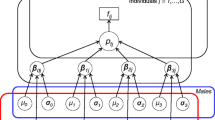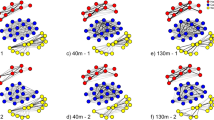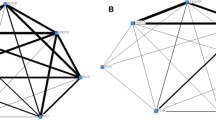Abstract
Precisely how ecological factors influence animal social structure is far from clear. We explore this question using an agent-based model inspired by the fission–fusion society of spider monkeys (Ateles spp). Our model introduces a realistic, complex foraging environment composed of many resource patches with size varying as an inverse power law frequency distribution with exponent β. Foragers do not interact among them and start from random initial locations. They have either a complete or a partial knowledge of the environment and maximize the ratio between the size of the next visited patch and the distance traveled to it, ignoring previously visited patches. At intermediate values of β, when large patches are neither too scarce nor too abundant, foragers form groups (coincide at the same patch) with a similar size frequency distribution as the spider monkey’s subgroups. Fission–fusion events create a network of associations that contains weak bonds among foragers that meet only rarely and strong bonds among those that repeat associations more frequently than would be expected by chance. The latter form subnetworks with the highest number of bonds and a high clustering coefficient at intermediate values of β. The weak bonds enable the whole social network to percolate. Some of our results are similar to those found in long-term field studies of spider monkeys and other fission–fusion species. We conclude that hypotheses about the ecological causes of fission–fusion and the origin of complex social structures should consider the heterogeneity and complexity of the environment in which social animals live.






Similar content being viewed by others
References
Alexander RD (1974) The evolution of social behavior. Ann Rev Ecolog Syst 5:325–383
Anderson DP (2002) Factors influencing fission–fusion grouping in chimpanzees in the Täi National Park, Côte d’Ivoire. In: Watts D, Mitani J, Boesch C, Hohmann G, Marchant L (eds) Behavioural diversity in chimpanzees and bonobos. Cambridge University Press, Cambridge, pp 90–101
Batagelj V, Mrvar A (1998) Pajek—program for large network analysis. Connections 21:47–57. (homepage: http://vlado.fmf.uni-lj.si/pub/networks/pajek/)
Bawa KS, Kang H, Grayum MH (2003) Relationships among time, frequency, and duration of flowering in tropical rain forest trees. Am J Bot 90:877–887
Bonabeau E, Dagorn L, Freon P (1999) Scaling in animal group-size distributions. Proc Natl Acad Sci U S A 96:4472–4477
Boyer D, Ramos-Fernández G, Miramontes O, Mateos JL, Cocho G, Larralde H, Ramos H, Rojas F (2006) Scale-free foraging by primates emerges from their interaction with a complex environment. Proc R Soc Lond B Biol Sci (in press). DOI:10.1098/rspb.2005.3462
Bradbury JW, Vehrencamp SL (1976) Social organization and foraging in emallonurid bats. II. A model for the determination of group size. Behav Ecol Sociobiol 1:383–404
Chapman CA, Chapman LJ, Wangham R, Hunt K, Gebo D, Gardner L (1992) Estimators of fruit abundance of tropical trees. Biotropica 24:527–531
Chapman CA, White FJ, Wrangham RW (1993) Defining subgroup size in fission–fusion societies. Folia Primatol 61:31–34
Chapman CA, Wrangham RW, Chapman LJ (1995) Ecological constraints on group size: an analysis of spider monkey and chimpanzee subgroups. Behav Ecol Sociobiol 36:59–70
Condit R, Ashton AS, Baker P, Bunyavejchewin S, Gunatilleke S, Gunatilleke N, Hubbell SP, Foster RB, Itoh A, LaFrankie JV, Lee HS, Losos E, Manokaran N, Sukumar R, Yamakura T (2000) Spatial patterns in the distribution of tropical trees. Science 288:1414–1418
Connor RC, Wells RS, Mann J, Read AJ (2000) The bottlenose dolphin: social relationships in a fission–fusion society. In: Mann J, Connor RC, Tyack PL, Whitehead H (eds) Cetacean societies: field studies of dolphins and whales. University of Chicago Press, Chicago, pp 91–126
Enquist BJ, Niklas KJ (2001) Invariant scaling relations across tree-dominated communities. Nature 410:655–660
Enquist BJ, West GB, Charnov EL, Brown JH (1999) Allometric scaling of production and life-history variation in vascular plants. Nature 401:907–911
Garber PA (2000) Evidence for the use of spatial, temporal and social information by some primate foragers. In: Boinski S, Garber PA (eds) On the move: how and why animals travel in groups. University of Chicago Press, Chicago, pp 261–298
González MC, Lind PG, Herrmann HJ (2006) A system of mobile agents to model social networks. Phys Rev Lett 96:088702
Goodall J (1968) The behaviour of free-living chimpanzees in the Gombe Stream Reserve. Anim Behav Monogr 1:165–311
Granovetter M (1973) The strength of weak ties. Am J Sociol 78:1360–1380
Granovetter M (1983) The strength of weak ties: a network theory revisited. Sociol Theory 1:201–233
Hemelrijk CK (2000) Towards the integration of social dominance and spatial structure. Anim Behav 59:1035–1048
Hrdy SB (1977) The langurs of Abu: female and male strategies of reproduction. Harvard University Press, Cambridge, MA
Janson CH (1998) Experimental evidence for spatial memory in foraging wild capuchin monkeys, Cebus apella. Anim Behav 55:1229–1243
Janson CH (2000) Primate socio-ecology: the end of a golden age. Evol Anthropol 9:73–86
Kummer H (1968) Social organization of hamadryas baboons. University of Chicago Press, Chicago
Lusseau D (2003) The emergent properties of a dolphin social network. Proc R Soc Lond B 270(Suppl):186–188
Lusseau D, Newman MEJ (2004) Identifying the role that animals play in their social networks. Proc R Soc Lond B 271(Suppl):S477–S481
Lusseau D, Williams R, Wilson B, Grelier K, Barton TR, Hammond PS, Thompson PM (2004) Parallel influence of climate on the behaviour of Pacific killer whales and Atlantic bottlenose dolphins. Ecol Lett 7:1068–1076
Milton K (2000) Quo vadis? Tactics of food search and group movement in primates and other animals. In: Boinski S, Garber PA (eds) On the move: how and why animals travel in groups. University of Chicago Press, Chicago, pp 375–417
Newman MEJ (2000) Models of the small world. J Stat Phys 101:819–841
Newman MEJ, Watts DJ, Strogatz SH (2002) Random graph models of social networks. Proc Natl Acad Sci U S A 99:2566–2572
Newstrom LE, Frankie GW, Baker HG, Colwell RK (1994) Diversity of long-term flowering patterns. In: McDade LA, Bawa KS, Hespenheide HA, Hartshorn GS (eds) La selva: ecology and natural history of a neotropical rain forest. University of Chicago Press, Chicago, pp 142–160
Newton-Fisher NE, Reynolds V, Plumptre AJ (2000) Food supply and chimpanzee (Pan troglodytes schweinfurthii) party size in the Budongo Forest Reserve, Uganda. Int J Primatol 21:613–628
Niklas KJ, Midgley JJ, Rand RH (2003) Tree size frequency distributions, plant density, age and community disturbance. Ecol Lett 6:405–411
Pelissier R (1998) Tree spatial patterns in three contrasting plots of a southern Indian tropical moist evergreen forest. J Trop Ecol 14:1–16
Pepper JW, Mitani JC, Watts DP (1999) General gregariousness and specific social preferences among wild chimpanzees. Int J Primatol 20:613–632
Pulliam HR, Caraco T (1984) Living in groups: is there an optimal group size? In: Krebs JR, Davies NB (eds) Behavioural ecology: an evolutionary approach. Blackwell Scientific, Oxford, pp 122–147
Ramos-Fernández G (2001) Patterns of association, feeding competition and vocal communication in spider monkeys, Ateles geoffroyi. Ph.D. dissertation, University of Pennsylvania. http://repository.upenn.edu/dissertations/AAI3003685/
Ramos-Fernández G (2005) Vocal communication in a fission–fusion society: do spider monkeys stay in touch with close associates? Int J Primatol 26:1077–1092
Ramos-Fernández G, Ayala-Orozco B (2003) Population size and habitat use in spider monkeys at Punta Laguna, Mexico. In: Marsh LK (ed) Primates in fragments: ecology and conservation. Kluwer, New York, pp 191–210
Ramos-Fernández G, Mateos JL, Miramontes O, Larralde H, Cocho G, Ayala-Orozco B (2004) Levy walk patterns in the foraging movements of spider monkeys (Ateles geoffroyi). Behav Ecol Sociobiol 55:223–230
Sjöberg M, Abrectsen B, Hjälten J (2000) Truncated power laws: a tool for understanding aggregation patterns in animals? Ecol Lett 3:90–94
Smolker R (2000) Keeping in touch at sea: group movement in dolphins and whales. In: Boinsky S, Garber PA (eds) On the move: how and why animals travel in groups. University of Chicago Press, pp 559–586
Stevenson PR, Quiñones MJ, Ahumada JA (1998) Annual variation of fruiting pattern using two different methods in a lowland tropical forest at Tinigua National Park, Colombia. Biotropica 30:129–134
Symington MM (1988) Food competition and foraging party size in the black spider monkey (Ateles paniscus chamek). Behaviour 105:117–134
Symington MM (1990) Fission–fusion social organization in Ateles and Pan. Int J Primatol 11:47–61
te Boekhorst IJA, Hogeweg P (1994) Self-structuring in artificial chimps offers new hypotheses for male grouping in chimpanzees. Behaviour 130:229–252
Trivers RK (1972) Parental investment and sexual selection. In: Campbell B (ed) Sexual selection and the descent of man. Aldine, Chicago, pp 139–179
van Roosmalen MGM, Klein LL (1987) The spider monkeys, genus Ateles. In: Mittermeier RA, Rylands AB (eds) Ecology and behavior of neotropical primates. World Wide Fund, Washington, pp 455–537
van Schaik CP (1989) The ecology of social relationships amongst female primates. In: Standen V, Foley RA (eds) Comparative socioecology: the behavioural ecology of humans and other mammals. Blackwell, Oxford, pp 195–218
van Schaik CP, Janson CH (2000) Infanticide by males and its implications. Cambridge University Press, Cambridge
White FJ, Wrangham RW (1988) Feeding competition and patch size in the chimpanzee species Pan paniscus and Pan troglodytes. Behaviour 105:148–164
Whitehead H (1999) Testing association patterns of social animals. Anim Behav 57:26–29
Wilson WG, Richards SA (2000) Consuming and grouping: resource-mediated aggregation. Ecol Lett 3:175–180
Wrangham RW (1979) On the evolution of ape social systems. Soc Sci Inf Stud 18:334–368
Wrangham RW (1980) An ecological model of female-bonded primate groups. Behaviour 75:262–300
Wrangham RW, Chapman CA, Clark-Arcadi AP, Isabirye-Basuta G (1996) Social ecology of Kanyawara chimpanzees: implications of understanding the costs of great ape groups. In: McGrew WC, Marchant LF, Nishida T (eds) Great ape societies. Cambridge University Press, Cambridge, pp 45–57
Acknowledgements
Louise Barret, Colin A. Chapman, Anthony Di Fiore, S. Peter Henzi, Phyllis Lee, and Julia Lehmann provided useful comments on a previous version of this manuscript as did other participants in the workshop on Fission–Fusion Societies and Cognitive Evolution organized by Filippo Aureli, Colleen Schaffner and Cristophe Boesch and sponsored by the Wenner-Gren Foundation for Anthropological Research. We thank David Lusseau and an anonymous reviewer for fruitful suggestions during the review process. Funding was received from the following institutions: the Tomás Brody visiting scholarship from the Institute of Physics, CONACYT (Grant number 40867-F), the National Autonomous University of Mexico (UNAM), the National Polytechnic Institute of Mexico (IPN), and the Fondo Sectorial CONACYT-SEMARNAT (project 0536). All experiments comply with the current laws of Mexico.
Author information
Authors and Affiliations
Corresponding author
Additional information
Communicated by D. Watts
Rights and permissions
About this article
Cite this article
Ramos-Fernández, G., Boyer, D. & Gómez, V.P. A complex social structure with fission–fusion properties can emerge from a simple foraging model. Behav Ecol Sociobiol 60, 536–549 (2006). https://doi.org/10.1007/s00265-006-0197-x
Received:
Revised:
Accepted:
Published:
Issue Date:
DOI: https://doi.org/10.1007/s00265-006-0197-x




